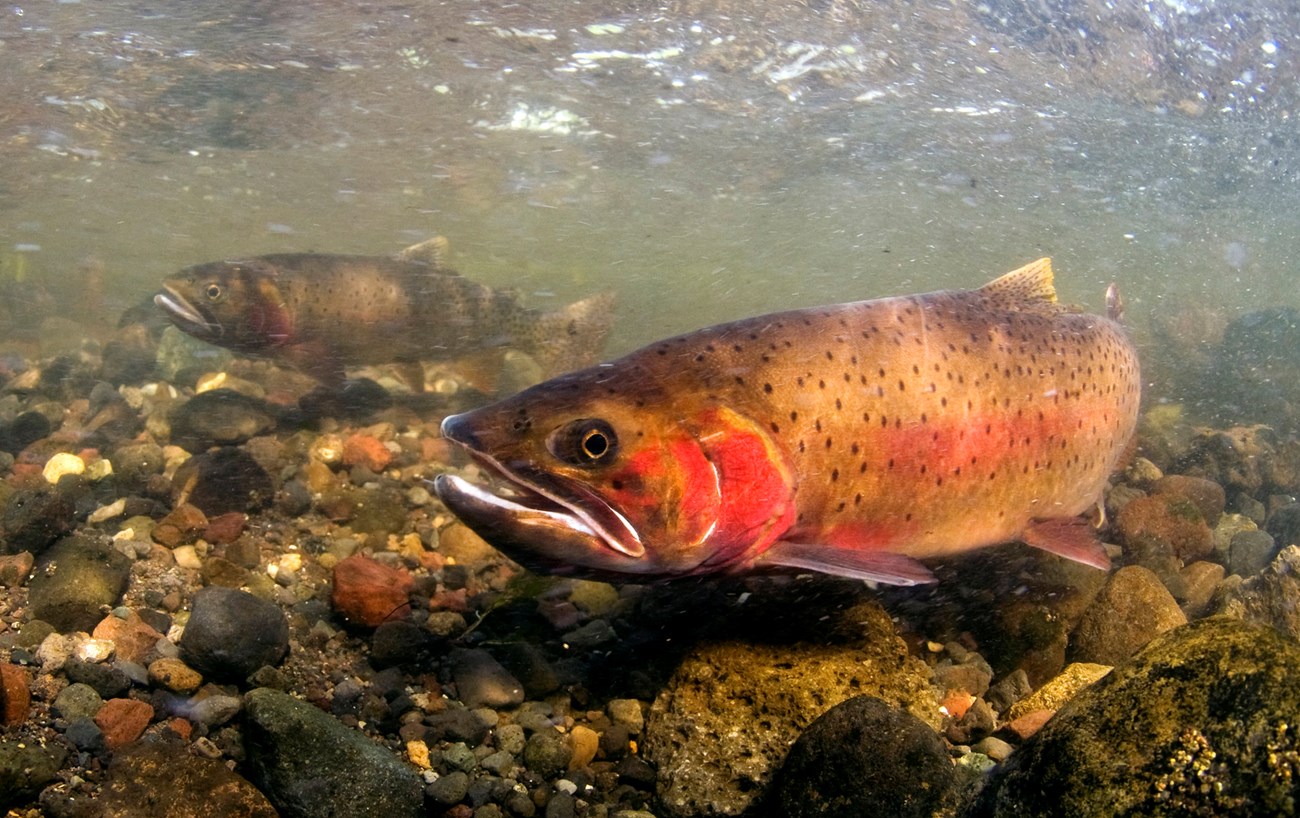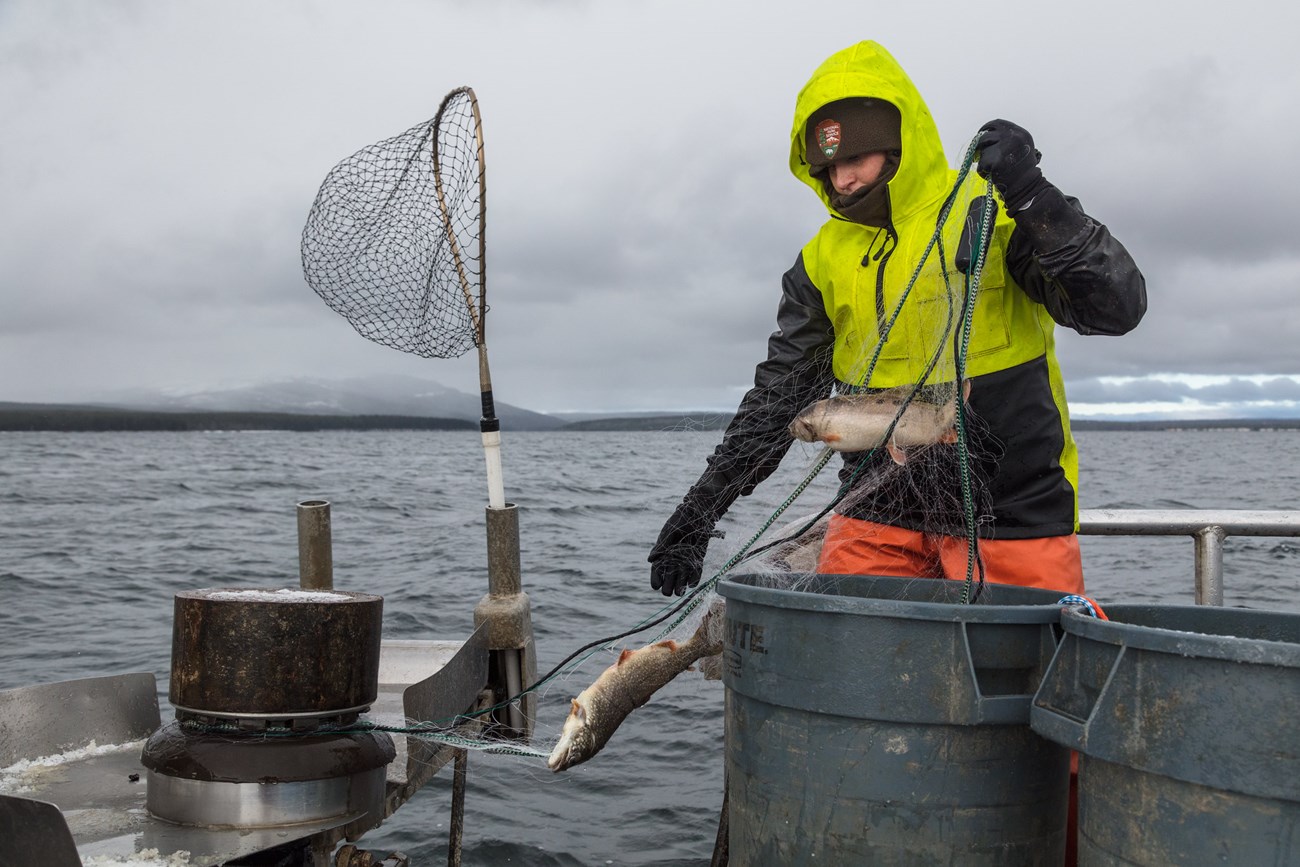Last updated: August 13, 2025
Article
Collaborating to Save Yellowstone Cutthroat Trout
An ongoing partnership with Yellowstone Forever is protecting the park’s iconic cutthroat trout—and, in turn, many other animals too.

NPS / Jay Fleming
It’s summer in Yellowstone National Park, which means crews of contracted fishermen and National Park Service biologists have been undertaking what’s become an annual task in the heart of the park. Clad in rubber boots and lifejackets, they’ve been unspooling miles upon miles of gillnetting—special underwater nets that catch fish by the gills—throughout Yellowstone Lake, the largest high-elevation body of water in North America.
By mid-October, when they wrap up the project for the season, they’ll have released and retrieved an astonishing 5,000 miles of netting.
Their target? Invasive lake trout, which were discovered in the lake in 1994 and promptly raised alarm bells among biologists who had seen them wipe out native trout populations in other western lakes. In the case of Yellowstone Lake, biologists worried about what might happen to its treasured population of Yellowstone cutthroat trout, an olive-colored fish adorned with black spots and a splash of bright orange on its gills.
And they had good reason to be worried: As a keystone species, cutthroat trout are essential to the park’s food web, serving as an important food source for grizzly bears, osprey, river otter, and other critters.
“After glaciation, cutthroat were the sole trout in the lake for thousands of years, and so they evolved as being a primary food source for these other animals,” explained Todd Koel, leader of Yellowstone’s Native Fish Conservation Program.
Even local economies outside the park benefit from a healthy population of Yellowstone cutthroat trout, which has lured fly fishing tourists to the area for generations.
“Anglers from all over the world come here to try and get a chance to catch these big, beautiful fish,” said Drew MacDonald, a native fish conservation technician for NPS in an online webinar about the program.

NPS/Jacob W. Frank
So, why are lake trout such a threat to Yellowstone cutthroat? One factor is their ability to reproduce rapidly. Just one single female can lay thousands of eggs each year. Another factor is their voracious appetite. It's not uncommon to find cutthroat trout in the bellies of lake trout, given just one mature adult can eat up to 41 native Yellowstone cutthroat trout annually. Yet another factor is the lake trout’s habit of dwelling in deep waters, where they’re unreachable by predators like bears and osprey.
Sure enough, by the mid-to-late-2000s, the lake trout had made it presence known: Yellowstone Lake’s population of spawning cutthroat trout had plummeted to just 5-10 percent of what it was in the late 1970s. Consequently, rangers began to notice a decrease in wildlife sightings around the lake, and anglers reported fewer successful catches. Some fishing outfitters even scaled back their trout-guiding expeditions in certain areas of the park, due the lack of cutthroat in spawning streams.
But things have been changing — and not by accident. After decades of dwindling numbers, the Yellowstone cutthroat trout are back. “And they’re beautiful,” adds Koel, who attributes their return to the park’s ambitious gillnetting program, considered one of the largest and longest-running nonnative fish suppression projects in the country.
In 2024 alone, the program caught 264,000 invasive lake trout, contributing to a remarkable total of over 4.9 million caught since the park began gillnetting began in 1995. As a result, the park has reduced the number of predatory lake trout (or those aged 6 and above) by about 90 percent, giving the Yellowstone cutthroat trout a chance to recover.
“It's amazing—the cutthroat are running up spawning streams again, and we're having bear activity like we haven't seen in quite a long time on these streams, because they're feeding on these cutthroat,” says Koel, who notes that bald eagles are back and that ospreys are starting to return too. “From an angler's perspective, the fishing is unbelievable. The fish are huge and numerous."
Of course, helping the park get to this point took a lot of support—a significant chunk of which comes from Yellowstone’s philanthropic partner, Yellowstone Forever. The nonprofit has been raising approximately $1 million dollars each year for the park’s native fish program, which not only protects Yellowstone cutthroat trout but also focuses on reducing the extinction risk for other native fish, like Arctic grayling and westslope cutthroat trout.
“We wouldn’t be here without their help,” says Koel, who added that the nonprofit also funds the park’s 21-year-old Fly Fishing Volunteer program, which further contributes to native fish research. As part of the program, volunteer anglers travel from all around the country to wade into Yellowstone’s rivers, creeks, and lakes and “fly fish for science” by recording the data from the fish they catch.
“Yellowstone Forever is proud to be a key partner in supporting this project,” said Lisa Diekmann, president and CEO of Yellowstone Forever, in a statement. “The results are incredible, as noted by biologists who are once again seeing an abundance of Yellowstone cutthroat trout and other native fish species.”
While the return of Yellowstone’s cutthroat trout is a much-celebrated success between the park and the nonprofit, the work is far from over. As long as lake trout remain in the waters, the park will continue its gillnetting operations and researchers will continue studying the impacts of invasive fish suppression.
“At this point, it almost becomes like maintaining roads, fixing the boilers in the buildings, rebuilding the walkways and trails—all this kind of stuff that goes on in Yellowstone, the suppression of lake trout is kind of like that,” says Koel. “We will continue in the future to maintain the ecosystem.”
To learn more Yellowstone’s Native Fish Conservation Program, visit Fish Management - Yellowstone National Park (U.S. National Park Service). Or, to discover more ways Yellowstone Forever is supporting the park and how you might get involved, visit Projects We Fund - Yellowstone Forever.
